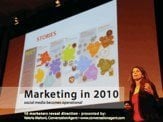This post was written originally for Valeria Maltoni’s  excellent new ebook about marketing in 2010. It includes terrific, thoughtful insights from Shannon Paul, Olivier Blanchard, Danny Brown, Amber Naslund, Jackie Huba, Gavin Heaton, Mark Earls, Rachel Happe, Jonathan MacDonald, and of course Valeria herself. Download it for free right here.
excellent new ebook about marketing in 2010. It includes terrific, thoughtful insights from Shannon Paul, Olivier Blanchard, Danny Brown, Amber Naslund, Jackie Huba, Gavin Heaton, Mark Earls, Rachel Happe, Jonathan MacDonald, and of course Valeria herself. Download it for free right here.
Change Is At Hand
Marketing has changed a lot since an enterprising caveman promoted his arrow points as “superior in every way – mammoths don’t stand a chance.” But, the real-time Web will change marketing more in 24 months than in the proceeding 20,000 years.
That’s because the real-time Web and its social media gasoline fundamentally change the relationship between company and customer. Every marketing shift heretofore has been rooted in the company being able to reach its customer in a more impactful (TV) or more efficient (demographics and psychographics) fashion.
Now, however, the taxonomy of war that defined marketing (targeting, flight, impact) is an anachronism. Campaigns are eroding. In this real-time epoch, every interaction with a customer or prospect is a separate, fluid, and potentially critical marketing initiative.
The balance of power has moved, inexorably and forever, from the company to the customer. When a real-time meme can erode brand trust that has taken years or decades to establish, we as marketers are no longer in control of the asylum.
The good news is that many brands have chosen to embrace the real-time Web and social media as a groundbreaking way to foster customer kinship with the brand, rather than trying to ignore or squelch consumers’ newfound power.
 And in 2010, we’re going to move from experimentation to methodology. It will be the year that the real-time Web and social media become operationalized. There are already plenty of companies clearing a path for everyone else, but this will be the year when we all start to get on the same page as to what’s “right” and what’s misguided. I see five key areas where this will occur.
And in 2010, we’re going to move from experimentation to methodology. It will be the year that the real-time Web and social media become operationalized. There are already plenty of companies clearing a path for everyone else, but this will be the year when we all start to get on the same page as to what’s “right” and what’s misguided. I see five key areas where this will occur.
1. What’s the Point?
There is a growing dichotomy between brands that use social media and the real-time Web as an outbound marketing tactic, and those that use similar tools and outposts as a customer service and CRM effort. (consider how Dell and Comcast use Twitter very differently, but successfully)
To date, companies have been able to seamlessly experiment with both approaches, using similar tools, venues, and personnel. This year, however, brands will pick one strategic use (either customer acquisition or customer retention) and flesh it out, or create bifurcated programs to address both – but in separate venues. (Twitter for promotion and a private brand community for feedback solicitation, for example)
We’re going to see best practices and conventional wisdom coalescing around what the best and highest use is for particular tools and platforms.
2. The Marketing-Centric Enterprise
The real-time Web makes everything marketing’s responsibility. It used to be that if you had a problem with a hotel, you’d call the front desk. Or if you really had an issue, you’d call the 800 number, or write a letter and your concerns would be addressed by the hotel’s operations or customer service department.
Now, you can send a tweet, update your Facebook status, write a blog post, or craft a review on Yelp, or TripAdvisor, or Google Sidewiki. Then it becomes the responsibility of the marketing department to locate, triage, and assuage your concern.
This puts marketing at the center of day-to-day corporate existence in a way it has never been historically. Operational shortcomings, customer service snafus, financial mishaps, R&D blunders, CEO peccadilloes. It all has the potential to bubble up in the real-time Web, and therefore it all impacts marketing.
Thus, we’ll see marketing as the binding agent that brings disparate corporate departments together to create cross-functional teams. The real-time Web forces collaboration, with marketing as the quarterback.
3. Staffing and Budget Clarity
Fortunately, the misguided notion that social media and conversation marketing are inexpensive is fading away. The expense is simply shifted from media and production, to personnel.
In 2010 we’ll see the emergence of best practices around real-time Web staffing. What types of employees are needed? Do you need round-the-clock monitoring? What’s the role of the agency, in comparison to the brand? All of these questions are being answered by brands via trial and error today.
While the issue of social media for customer acquisition vs. customer retention will impact staffing decisions somewhat, we’ll see the adoption of social media execution “field manuals” – similar to how corporate social media policies are achieving greater standardization in late 2009.
(Note that my friend Amber Naslund has done some excellent work on social media staffing patterns, and has an ebook about that subject).
In addition to increased clarity regarding personnel and roles, we’ll see social media become a budget line item for a majority of companies in 2010, even mid-sized and small businesses. The resources needed to harness the real-time Web now clearly transcend the “test and learn” method of skimming a few budget dollars from here and there.
4. Rules of Engagement
As Amber said recently in a MarketingProfs Webinar we did with Beth Harte and Ann  Handley, “one negative tweet doesn’t mean you have a brand crisis.” This is true. Except when it’s not.
Handley, “one negative tweet doesn’t mean you have a brand crisis.” This is true. Except when it’s not.
(photo by freakapotimus)
Because the real-time Web puts all manner of customer communication through the bailiwick of marketing, we need to develop far more numerous, and nuanced mechanisms for engaging with customers, prospects, and critics.
In many companies today, the same people are responding to positive and negative customer comments, on an ad hoc basis, with very little in the way of predetermined messaging, or desired outcomes.
2010 will be the year that the real-time Web forces marketers to act more like call center managers. We’re going to need to create or codify rules of engagement for who and how and why and whether the brand responds to or interacts with consumers.
This will unavoidably remove some of the spontaneity and spunk from social media interactions, but the tradeoff of a more logical, assured communication program will be a worthy exchange.
5. Back to the Future – Social Media in Retrograde
Maybe we’ve gotten a little ahead of ourselves?
In our zeal for YouTube videos, and Facebook apps, and iphone wizardry, and augmented reality we’ve in many cases neglected the many ways we can socially enable the marketing we’ve been doing all along.
In 2010, we’ll retrofit our email marketing, search marketing, banner advertising, even print and TV, to include social components universally. I hope we’ll focus on getting the basics done well before we move forward with the cutting edge opportunities. Because that’s a long-term positive.
Sure, the real-time Web is disruptive and powerful, but it can’t do all the work all by itself. We need to treat social media as a marketing ingredient, not a marketing cure-all, and adding conversational frosting to our historical communication methodologies is the first step toward moving beyond hype and toward operationalizing.
Here’s hoping 2010 is the year that the real-time Web and social media become less special, not more. Eventually, every company will have a social component, and then it will just be the way marketing gets conducted in the modern age. Let’s start down that path together in the months ahead.
What is your #1 priority for operationalizing social media next year?

